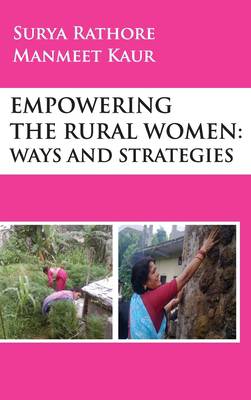
- Afhalen na 1 uur in een winkel met voorraad
- Gratis thuislevering in België vanaf € 30
- Ruim aanbod met 7 miljoen producten
- Afhalen na 1 uur in een winkel met voorraad
- Gratis thuislevering in België vanaf € 30
- Ruim aanbod met 7 miljoen producten
Zoeken
€ 332,45
+ 664 punten
Omschrijving
To address the goal 5 (Gender Equality) of Sustainable Development, it is deemed vital that we first understand the gender inequalities and the contribution of the second gender, i.e. women. We need to bring women into the mainstream to bring both genders at par. Since most of our population lives in villages, we need to have an in-depth knowledge of rural women's role in the development and understand the means and ways to empower them holistically, be it in terms of education, social, technological, political, legal etc. Today's environment calls for a need for women in rural areas to go in for bringing the various drudgery-reducing technologies into practice as well as empower themselves economically through Self Help Groups (SHGs). Rural women must understand the coping strategies associated with climate change which is again a challenge, and the use of Information and Communication Technologies (ICTs) to be more informed and empowered citizens for the welfare of their families, communities, societies and the nation at large. To attain the national goal of doubling the farmers' income by 2022, rural women's economic contribution must be increased through entrepreneurship. To make this dream come true, rural women need to be educated, malnutrition in rural areas; especially among women, needs to be removed, they will have to be technologically empowered, and rural women need to break the shackles of traditional hiccups and be aware of the latest information related to government programmes and schemes along with legal literacy concerning them to be able to understand the various provisions made available by the government for them and to enable them to enforce the same.This book encapsulated all the required dimensions of rural women empowerment: education, health & nutrition, technological empowerment, political empowerment instruments like the Panchayati Raj system, economic empowerment through entrepreneurship, etc. It covers the health challenges of women labourers, hill women, drudgery issues of brick layering women, women and Corporate Social Responsibility (CSR), and constriants to women's empowerment. A few case studies and success stories of women entrepreneurs find their place in this book. The book also provides solutions to the issues of rural women, such as knowledge about those government schemes and programmes that empower women and provides women strength with the golden rays of constitutional mandates to make them sabla from abla. In a nutshell, this book provides conceptual clarity regarding the concept of women empowerment, the different dimensions of empowerment, issues and strategies to cope with the same in one place.
Specificaties
Betrokkenen
- Auteur(s):
- Uitgeverij:
Inhoud
- Aantal bladzijden:
- 248
- Taal:
- Engels
Eigenschappen
- Productcode (EAN):
- 9789395319621
- Verschijningsdatum:
- 29/03/2023
- Uitvoering:
- Hardcover
- Formaat:
- Genaaid
- Afmetingen:
- 152 mm x 229 mm
- Gewicht:
- 503 g

Alleen bij Standaard Boekhandel
+ 664 punten op je klantenkaart van Standaard Boekhandel
Beoordelingen
We publiceren alleen reviews die voldoen aan de voorwaarden voor reviews. Bekijk onze voorwaarden voor reviews.











